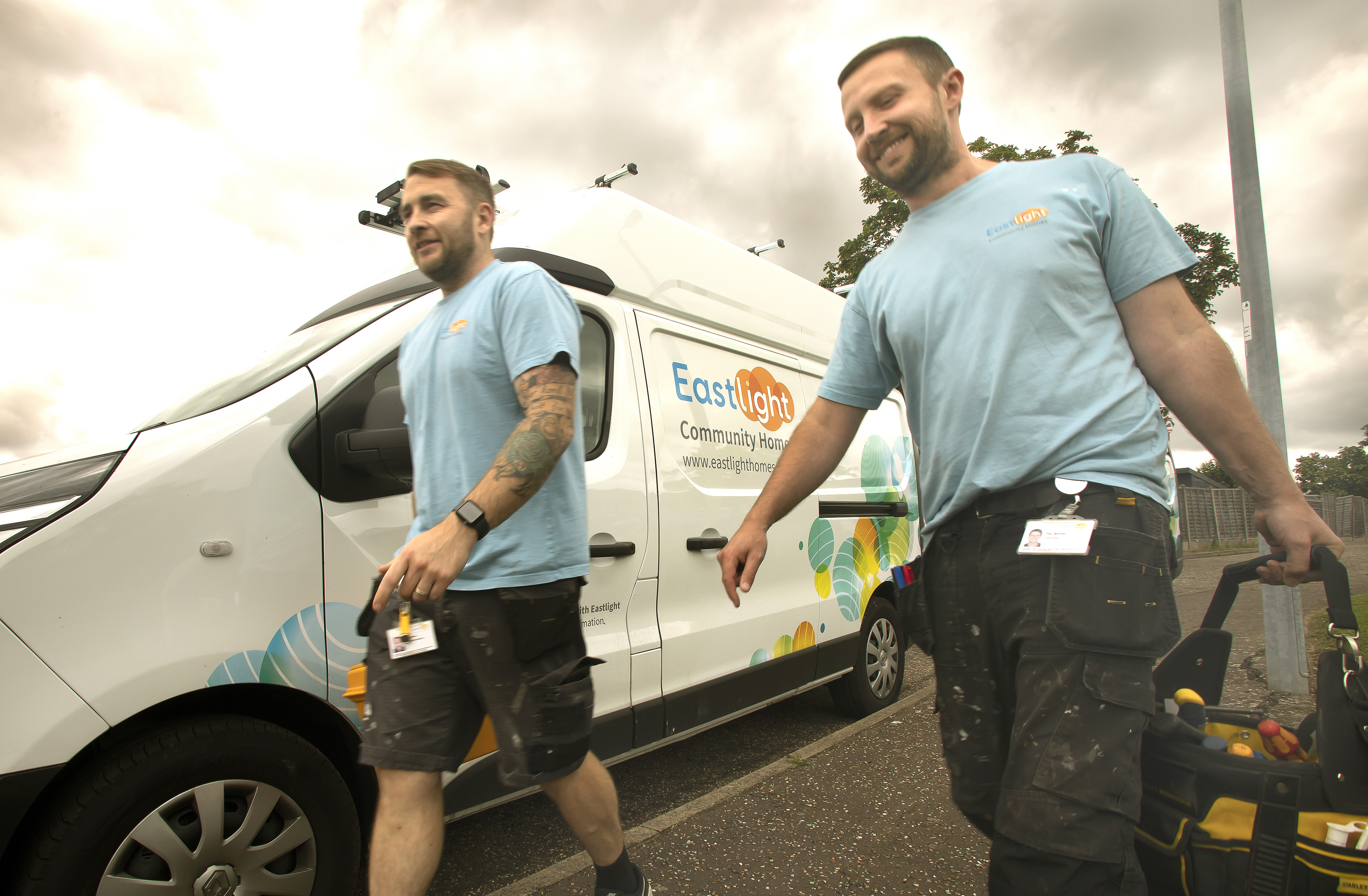We have four types of repairs, each with different timescales. They are:
1. Emergency
A serious risk to health, safety or security to you or your home. Includes a total loss of heating or electricity, a gas leak, a flood or a collapsed ceiling. We'll visit within 24 hours. Please call us on 0330 128 0330 to report emergencies.
2. Urgent
Faults and incidents which require prompt attention and which may cause inconvenience but do not pose an immediate risk to you or your home. We'll visit within seven calendar days. Please report through the form below.
3. Routine
No risk to you or your home. The issue may cause an inconvenience but not adversely affect the use of your home. We'll visit within 28 calendar days.
Report a non-urgent repair here
4. Planned
Fencing and larger building works where there is no risk to you or your home. We'll visit within 90 calendar days.
For more information on how we can support you to navigate our website, forms and documents, visit our Extra Support page.
You are responsible for keeping your home clean and in good order. This could mean you face a charge for damage not caused by normal wear and tear. For more information, read our Recharge Policy.
We will discuss any recharges before beginning any work.
Examples of rechargeable repairs include:
- An electrical repair caused by a defective appliance
- A drain blockage caused by something you or visitors have done, such as flushing inappropriate materials down the sink or toilet
- If you get locked out of your home and need help to gain entry.
Eastlight is responsible for the majority of the repairs in your home, but you are responsible for some, also. Click here to see who is responsible for what (Section 11, Appendix A).
Our Repairs Pledge sets out the repairs service you should expect to receive from us.
It has been created by a group of Eastlight staff and residents, who worked together to identify what matters to you when you need a repair and how we can meet your expectations.
Our teams are proud of the service we provide. However, we recognise that we don’t get it right all of the time.
Your feedback helps us identify where we should be doing better, so please get in touch if something isn’t right.
When I request a repair…
- I will receive a friendly and professional response from Eastlight’s Customer Service Team.
- We will clearly communicate when we will visit your home to carry out the repair.
- We will explain the priority level of your repair, and if you are not happy we will find an alternative solution, where possible.
When you carry out a repair…
- We will contact you before your appointment to double check you still require the repair.
- If we have to postpone your repair, if at all possible, we will contact you in advance to rearrange it.
- Our tradesperson will be polite, professional and complete your repair to a high standard.
When further repairs are required…
- We will keep you updated about progress, letting you know as soon as possible when we can complete the repair.
- If there are issues which will delay your repair, we will keep you posted.
- Wherever possible, we will send the same tradesperson to carry out the work.
After the repair is completed…
- We will tidy up after ourselves and leave your home in the condition we found it in.
- If there are any issues with your repair, please let us know and we will investigate and put it right.
- We will listen to your feedback and use it to make improvements to your repairs service.
Report and change repairs in just a few clicks!
Introducing your new My Eastlight Portal and app.
DIY tips to keep your home warm in winter
It’s not always necessary to call out an engineer to fix your boiler and heating issues, or just to keep your home warmer for less. Sometimes an issue can be solved with a quick DIY fix that you try yourself if you wish to. See our guides below and please do contact us if you don't feel comfortable doing them yourself, there is an additional cost you are unable to cover, or they simply don't work.
In the winter, it's important to isolate your outside tap to prevent the water from freezing and causing pipes to burst. You can also insulate your pipes in unheated areas like lofts, roofs, outbuildings and garages.
You can do this by:
- Locating the isolation valve for the tap, which is usually inside your home. This valve is separate from the stopcock that controls the water supply for the entire property. The isolation valve is often found under the kitchen sink, but it could also be in the utility room or under the floorboards near the front door.
- Turning the isolation valve clockwise to shut off the water supply to the tap.
- Going outside and opening the tap to drain any remaining water from the pipework. Remove any hoses or attachments from the tap.
- Turning off the tap and leaving the isolation valve off until the weather warms up.
Many households have external condensate pipes that are vulnerable to freezing in the winter. A frozen boiler condensate pipe can prevent your boiler from functioning properly, leaving you without heating and hot water. There is also a risk of frozen pipes bursting and causing flooding, so we recommend turning your water off if you are away from home for more than 24 hours during freezing cold weather (see how to locate your stopcock/stoptap below).
Providing you have safe access to your condensate pipe, you should be able to unfreeze it with hot water.
To do this:
- Heat water in your kettle or microwave (make sure the water isn’t boiling as you could accidentally burn yourself or crack a frozen pipe)
- Transfer the water to a watering can or jug for easy pouring
- Slowly pour the water over the frozen section of the condensate pipe
- Pay attention to any flat surfaces or elbows where ice is more likely to form
If pouring hot water on your boiler condensate pipe doesn’t work, you could try using a hot water bottle instead. Leave it on the frozen section for a longer period. When you see water leaving the pipe or hear a trickling sound, you’ll know that the blockage has cleared.
If you’re having issues with your boiler taking it’s time to heat water, or not at all, you may need to top up your boiler pressure:
- Check the front of your boiler for pressure gauge (may be a digital or an actual gauge)
- If this is at 0 then you need to top up the pressure
- This needs to be done when the boiler and radiators are cold
- Please check your radiators and pipework for any signs of water leaks before doing anything else
- If leaks are found, please book a repair immediately
- If not, find your filling loop - it is a silver metal hose connected to two pipes
- Open the valves one at a time. You will hear a whooshing sound as the fresh water enters your heating system and boiler
- Keep an eye on the pressure gauge and stop when it reaches 1.2 bar, then shut off the filling loop.
If the drop in pressure was not due to an ongoing component fault, the pressure should remain at the normal level. If the pressure continues to drop, then the system may have a leak somewhere and needs to be inspected by an engineer.
Resetting your boiler can be relatively simple, and may kickstart your boiler back into shape. In order to reset your boiler, please refer to your boiler’s manual (by finding your hardcopy of the manual, or a quick search online) to find the reset button.
Usually, you will have to hold the reset button for 10 seconds. After a few minutes, the boiler should start working again. If it doesn’t work the first time, you can attempt the reset for a second time. However, please refer to the manual before you do this.
If a radiator is not getting hot when the central heating is active, this may be a tell tale sign that your radiators need bleeding.
Due to the simplicity of bleeding a radiator, you only need a selection of household items before starting the process, such as a dry cloth and a large bowl. The only specialist kit that is required is a radiator key - a small and cheap tool available on Amazon or at most DIY stores. To bleed your radiator correctly, you just need to follow a few simple steps:
- If your radiator is hot at the bottom, and cold at the top, then it is most likely filled with air and needs bleeding.
- You can easily bleed the radiator yourself but will need the few basic items mentioned above
- Make sure your radiators and boiler are cold before doing this, as hot water expands and will leave more air in the system
- The bleed valve will be at the top of the radiator, as air will rise to the top of the radiator
- Hold your cloth under the valve and insert your key into the square point
- Turn anti-clockwise and you will hear a hiss as the air is forced out by the water pressure
- You can close the bleed valve once water starts coming out.
After you complete these steps, we recommend that you check the pressure gauge on your boiler, as the process of bleeding radiators can cause pressure to drop. If this is the case, you can ‘top up’ the pressure (see above).
If your home feels too hot or too cold, there may be a problem with your thermostat. Take a look at the most common problems and their solutions below, to see if they help.
First, we recommend making sure your thermostat is sufficiently powered. If it’s battery-operated, you may find that the batteries need changing. You can usually tell if the battery is low as the LED screen will have faded and some of the info on the screen may be missing. Changing the batteries in your thermostat is very straightforward (depending on the model of your thermostat). In most cases, you will only need to remove the front cover and swap the old batteries for new.
Cracks, gaps and cold winter snaps do not mix well. In fact, a house can lose 25% of its warmth through draughty doors and windows. Draught excluders are widely available for under £10 and can be attached to the bottom of doors, windows, letterboxes and chimneys.
What you'll need
- Draft excluder
- Scissors.
How to fit a draught excluder
Self-adhesive foam strips of draught excluder are ideal for using on casement (has one or more hinges) windows and interior doors.
- Use a damp cloth to clean all dirt and any loose paint from the surface you’re sticking to
- Once dry, peel off the backing paper and press it onto the frame, where the opening will press against it when the window or door is closed
- You should aim to cut the ends of each length at a 45-degree angle to form a neat joint at each corner
- Close the window and press the strip firmly in place. Some draught excluders require drilling in place, but please request consent from Eastlight before drilling into a door or window, as you may cause damage. You can request consent here.
- Do not block ventilation designed to remove damp from your home.
You can prevent heat loss through exterior walls by using heat reflective foil. Attach it behind any radiator to reflect heat back into your home.
This low-cost and easy-to-install solution will help your radiators to heat to their maximum potential.
What you’ll need
- Radiator foil (also known as radiator reflector)
- Scissors
- A tape measure.
How to fit radiator foil
This job can be made easier by purchasing the correct size for your radiator. However, the sheet you buy can also be cut to size.
Radiators fixed to exterior walls (where heat can escape) should be priority. Measure between the brackets fixing the radiator to the wall, apply self-adhesive tape (normally supplied) and ensure the silver side is pointing into the room.
Radiator foil is not suitable for element or flame heaters.
Pipes need to be protected in winter to prevent freezing and bursting. The most cost-effective way of achieving this is a foam lagging/cover.
What you’ll need
- Pipe insulation (also known as lagging)
- Scissors or a stanley knife
- A tape measure.
How to fit pipe lagging
- Buying the correct size of insulation is important, so measure your pipe’s width and the length you need to cover
- Simply use the pre-slit opening to slide it around the pipe. If your pipe has a bend, cut the insulation to ensure a close, tight join.
Don’t forget unheated areas like the garage or boiler room, where covering the pipes will keep hot water flowing properly throughout winter. Lagging costs around £10, but will save you more and requires no expert fitting.
Open or unused chimneys are ready-made escape routes for heat to flow out of your house. Snow or ice can crack and crumble mortar inside a chimney, leaving more space for air to leak out.
You could fit a cap over the chimney pot on the roof. However, this should be done by a professional. A chimney balloon, which blocks the airway, can be bought from any DIY store for around £15 and is easy to install yourself.
What you'll need
- A chimney balloon (also known as a chimney draft excluder)
- A tape measure.
How to fit a chimney balloon
- An inflatable chimney balloon will fit a range of sizes, but, as chimneys vary so much, you need to purchase an appropriate size, so measure first
- The chimney balloon should fit snugly and be somewhere you can easily reach with the pump or mouth inflation tube
- Make sure the tap is open, and pump some air into the balloon so that it starts to inflate. Once it is partially inflated, put it in position to inflate it fully
- If you have a cast iron fire surround, make sure you can push it through the small gap before positioning it in the chimney to fully inflate.
You can use your thermostat and timer to save energy.
Keep the heating on a low constant temperature while you’re out of the house; we recommend 17-19°C. Once you’re home, 19-22°C is recommended.
If you have a routine, setting your timer will do the work for you and save both money and energy.
Ensure you know where your stop tap/ stopcock is, in case of emergencies. We recommend turning your water off if you are away from home for more than 24 hours during freezing cold weather, in case a pipe freezes and bursts, causing flooding.
If your central heating is damaged by poor weather, you need to turn off the water mains to stop potential flooding, if you are able. To do this, you need to find the stopcock or stop tap (a valve that looks like a tap without a spout), which is normally found under the sink.
If that isn’t the case, check the cupboard under the stairs or any utility rooms.
Turn the tap clockwise to shut off water. It’s a good idea to turn the tap regularly to stop it from sticking.
If you can do so safely and feel comfortable doing so, clear your gutters of leaves and debris to ensure water can flow freely. Otherwise, the water may build up and freeze, risking moisture and damp creeping through cracks and damaging the roof or walls.





